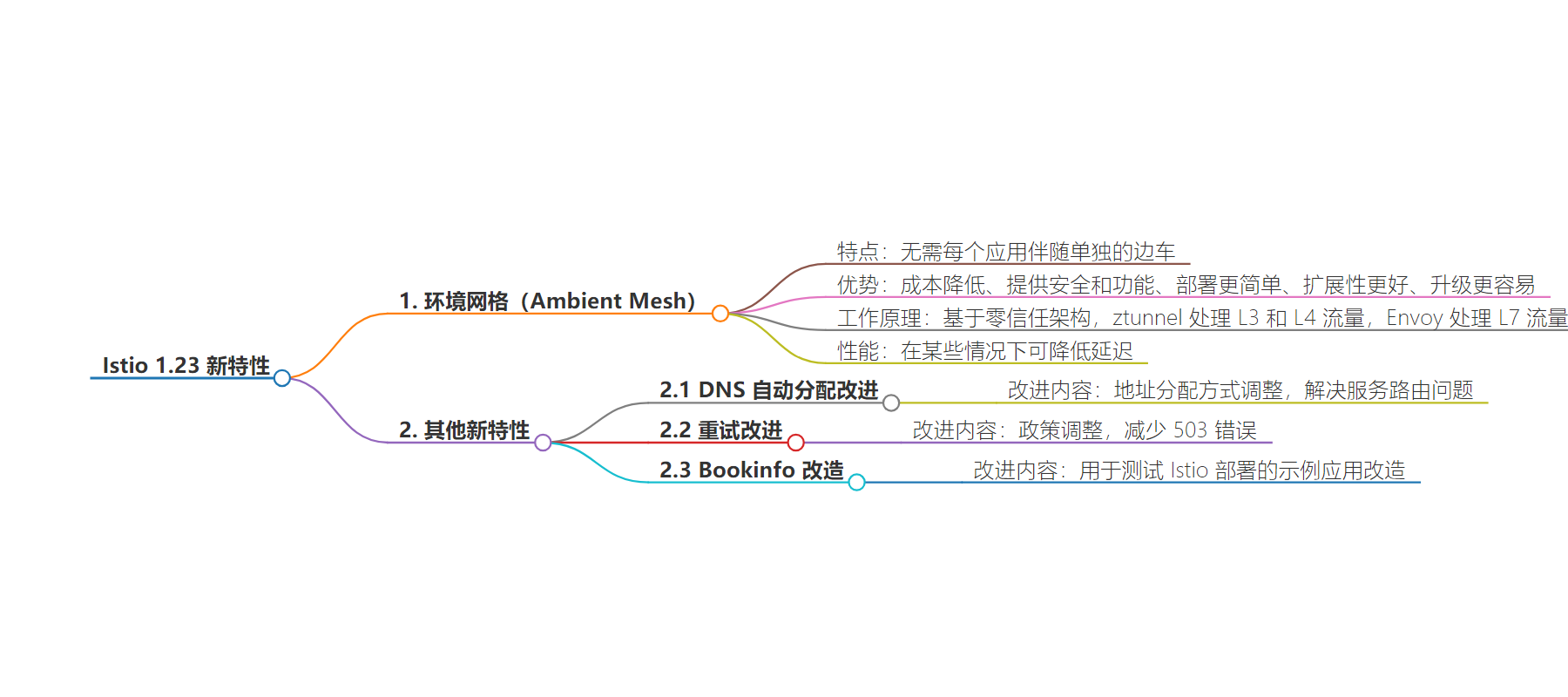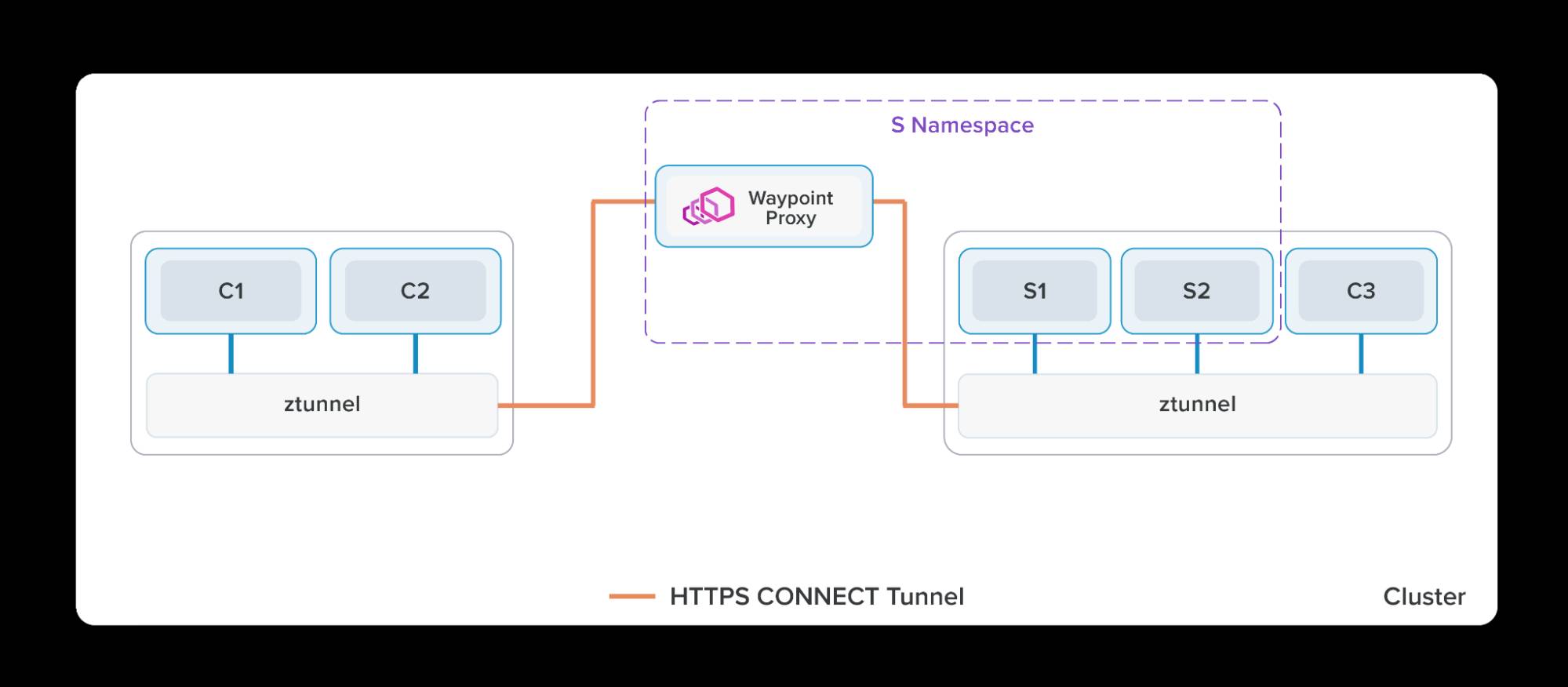包阅导读总结
1. 关键词:Istio 1.23、Ambient Mesh、Sidecar、Kubernetes、服务网格
2. 总结:
Istio 1.23 推出了新的 Ambient Mesh 选项,改变了处理 Kubernetes 流量的方式,不再需要单独的 Sidecar,具有成本低、部署快等优势,还可能降低延迟,同时该版本还有 DNS 分配、重试等方面的改进。
3. 主要内容:
– Istio 1.23 推出 Ambient Mesh 选项
– 作为生产级能力,是全新架构
– 解决了 Sidecar 带来的开销问题,仍提供所需安全性和功能
– 对比 Sidecar
– Sidecar 是微服务架构副产品,提供安全等功能但带来机器开销
– Ambient Mesh 减少成本,升级更易
– Ambient Mesh 工作原理
– 基于零信任架构,ztunnel 处理低层流量,Envoy 处理复杂高层流量
– 节省资源,管理端点少,功能内置到集群
– Istio Ambient 可能更快
– 某些情况下相比传统 Istio 降低延迟
– Istio 1.23 其他新特征
– DNS 自动分配改进
– 重试改进
– Bookinfo 应用更新
思维导图:
文章地址:https://thenewstack.io/istio-1-23-drops-the-sidecars-for-a-simpler-ambient-mesh/
文章来源:thenewstack.io
作者:Joab Jackson
发布时间:2024/8/19 22:52
语言:英文
总字数:832字
预计阅读时间:4分钟
评分:90分
标签:Istio,Kubernetes,无边车服务网格,服务网格,零信任架构
以下为原文内容
本内容来源于用户推荐转载,旨在分享知识与观点,如有侵权请联系删除 联系邮箱 media@ilingban.com

Louis Ryan, CTO, Solo.io
The new release of the open source Istio service mesh software offers a potentially big change in how to handle Kubernetes traffic, with the introduction of an ambient mesh option.
Although the technology has been offered as an experimental feature for several releases, the core development team taking feedback from users, this is the first release to offer the feature as a production-grade capability.
It’s a new architecture entirely, explained Louis Ryan, who is the CTO of commercial Istio provider Solo.io, as well as a member of Istio Technical Oversight Committee and Steering Committee,in a TNS interview. “It’s cheaper, faster, easier to deploy more scalable, better.”
An “ambient” service mesh is one that, unlike traditional approaches, does not require a separate sidecar to accompany each application.
Istio is a project of the Cloud Native Computing Foundation, making it a building block of many Kubernetes deployments.
Istio Sans Sidecar
The sidecar was a necessary byproduct of microservices architecture, noted Idit Levine, founder and CEO of Solo.io. Once applications are decomposed into individual services, these services require a way to communicate. Hence it made sense to festoon each service with a sidecar to handle all the networking traffic.
The sidecar provides security, improved reliability, and dynamic networking capabilities for each application.
Sidecars solved “a real problem,” Levine noted. The sidecar provided the functionality, but the designer “overlooked” how much overhead they would bring to the machine itself.
In contrast, the ambient approach “is reducing costs because there is no sidecar everywhere. But it’s still giving you the security that you’re looking for, and all the functionality,” Levine said. “So it’s actually really amazing.”
Solo.io engineers have been working on refining the ambient approach for several years now.
How Ambient Mesh Works
“This innovative approach makes networking in Kubernetes even easier. No more extra steps with sidecars. Services can now communicate more directly and simply,” wrote AWS community builder Seifeddine Rajhi, in a post explaining the technology.
Ambient Mesh is built on a zero trust architecture. The ztunnel zero trust tunnel, a daemonset pod written in Rust, is installed on each cluster to handle Layer 3 and Layer 4 traffic. Then, the Envoy-based Waypoint Proxies to handle more complex Layer 7 traffic for each namespace, Rajhi explained
So, as an example, for 50 pods, with each pod only receiving 50 requests per second, you can have a single proxy handle all of them. “That’s a massive resource savings,” Ryan pointed out.
There are other advantages as well. Upgrades are a lot easier, as applications do not need to be taken offline to assign a sidecar. Instead, updates of the daemonsets can be done on a rolling basis. This is where the “ambient” name comes in, meaning there are far fewer endpoints to manage. The functionality is built into the cluster itself.
“The user experience is just simple. It’s easy to install, it’s easy to operate. You don’t have a lot of overhead like we had with a sidecar model,” Levine enthused.

Running independent of the application, the waypoint proxy operates independently of the application itself.
Istio Ambient Could Be Faster too
And, despite its experimental nature, the ambient mesh, at least in some cases, can reduce latency, compared to a traditional Istio setup.
In a contributed post for The New Stack, Lin Sun, Solo.io director of open source and also a member of Istio Technical Oversight Committee and Steering Committee, demonstrated that Istio can actually reduce the latency of user applications in some cases.
To run the tests, she used both the Fortio load testing library and Istio’s own Bookinfo sample app.
“We’ve been taught that service meshes add latency,” Sun wrote. These results “show a case where a workload is faster when running through a service mesh.”
In this test, Sun replicated the results of an earlier test from site reliability engineer Quentin Joly, who found that:
Istio Ambient: 2.35ms latency;
Without Istio: 2.8ms latency;
Istio Sidecar: 39.3ms latency.
“It’s quite amazing that Istio Ambient manages to reduce latency compared to a cluster without Istio,” he wrote. “This shows that the ‘Ambient’ mode is a viable solution that can potentially improve the performance of your Kubernetes cluster.”
Other New Features to Istio 1.23
- DNS auto-allocation improvements: Address allocation has been revamped, solving a number of issues for service routing.“In the new approach, the allocated IP addresses are persisted in the ServiceEntry status field, ensuring that they are never changed,” the notes state.
- Retry Improvements: The retry policy has been revamped, with the changes now in preview, which aim to reduce 503 errors. To date, retries were only done with outbound traffic, with retries going to a different pod. A new detection routine has been added to determine if the destination application has closed the connection.
- Bookinfo revamp: The sample application used to test Istio deployments has been revamped.
YOUTUBE.COM/THENEWSTACK
Tech moves fast, don’t miss an episode. Subscribe to our YouTubechannel to stream all our podcasts, interviews, demos, and more.
